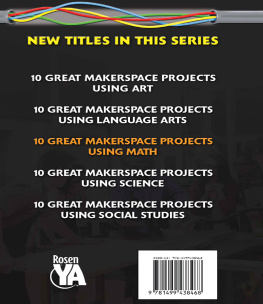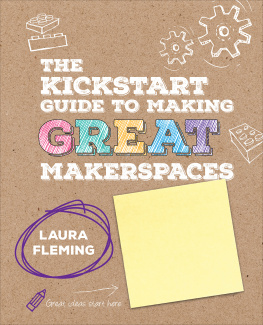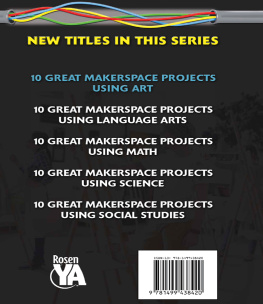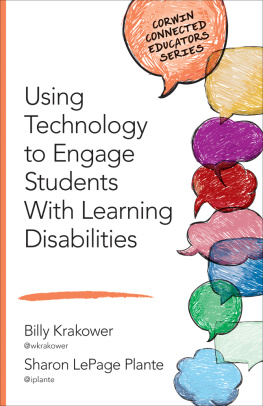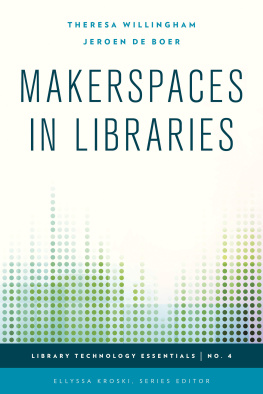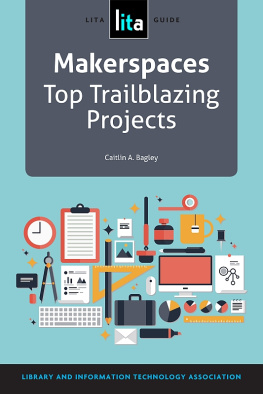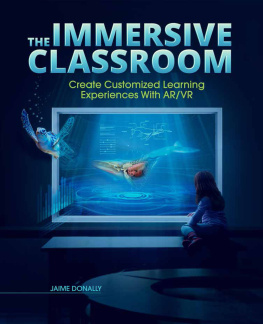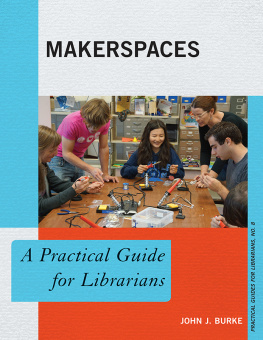Published in 2018 by The Rosen Publishing Group, Inc.
29 East 21st Street, New York, NY 10010
Copyright 2018 by The Rosen Publishing Group, Inc.
All rights reserved. No part of this book may be reproduced in any form without permission in writing from the publisher, except by a reviewer.
Names: Hinton, Kerry, author.
Title: 10 great makerspace projects using social studies / Kerry Hinton.
Description: First edition. | New York: Rosen Publishing, 2018. | Series: Using makerspaces for school projects | Includes bibliographical references and index. | Audience: Grade 6 to 12.
Subjects: LCSH: MakerspacesJuvenile literature. | Social sciencesStudy and teachingActivity programsJuvenile literature.
Today there are more than a thousand makerspaces and hackerspaces around the planet. This is more than ten times the number of these spaces there were ten years ago.
O ver the last thirty years, the tech advances mankind has made have been constant and frequent. Our televisions, computers, and video games have developed so much that it would seem unbelievable to people who lived just a century ago. Even the way we make things in the twenty-first century is different. In the past, manufacturing was limited to companies that had the large and expensive equipment to make the things we need and use every day. We are nearing a point where we will be able to do it from the comfort of our homes. Until that day comes, we have an alternative: makerspaces.
Makerspaces are centers of imagination and creativity where people of all ages can experiment with tools and technology. Until their existence, the average person would not have been able to walk into a manufacturing facility and use expensive computers and million-dollar machines. Access to many complex tools has become cheaper and much more available to the average citizen. The range of what can be made is impressive. People can sew, program, and fabricate almost anything from sock puppets to car parts. Makerspaces can be found in factories, libraries, schools, and even buses!
There are makerspaces on almost every continent on our planet. Some of them share projects and ideas with one another as they learn and create across man-made borders. Making is fun, but it also connects with what we learn in the classroom. It gives us the ability to improve our lives and bring the residents of our global village closer.
The projects in this book will help you better understand the connection between social studies and making. As you work through them, remember that every step of this process is a learning experience. There are no time limits and no rewards for getting it right the first time. The real reward is learning and then building on that to tackle other challenges.
CHAPTER ONE
SOCIAL STUDIES: WHAT IS IT, REALLY?
M ost students take social studies at some point during school, but it may be hard to define. Is it history? Geography? Yes, yesand quite a bit more. Actually, many other fields of studies are included under the umbrella that we call social studies.
Social studies is the study of the way people behave, connect, and work with one another all over the world. If this sounds broad, thats because it is. When you finish school, you will be a citizen of the world. Understanding that world is more important than ever. Technology is shortening the distance between people around the globe every day. Our neighbors dont just live next door to us anymoreyour online neighborhood is getting bigger.
The National Council for the Social Studies tells us that social studies promotes knowledge of and involvement in civic affairs ... such as health care, crime, and foreign policy. Its a big, wide world, and understanding it takes a big, wide base of knowledge. Social studies pulls knowledge from many subjects, including:
History. The study of the past.
Sociology. How humans and societies grow and develop.
Anthropology. The study of humans and their ancestors.
Political Science and Law. The study of government systems, politics, and the laws that govern them.
Economics. The study of the use and sale of goods and services.
Geography. The study of Earths surface, cities, climate, and natural features such as bodies of water, mountains, and deserts.
Since it covers so many different subjects, social studies enables us to take a wide view of how we are all connected.
In the world of the social sciences, all of these disciplines are connected. As technology grows, so does our ability to connect with people around the world. People connect in many different ways, not only from day to day but also from country to country. Not everyone enjoys the same living conditions. There are so many different things that affect this, including geography, climate, economics, and population. We study all the different subjects that make up social studies to understand not only our world but the world as other people have experienced it, in the past and also today.
Aside from the world at large, social studies is also concerned with the world thats closer to us. In order to be good global citizens, we need to be good citizens at home. This is called civicsits the study of our government and how we relate to it as citizens.
SOCIAL STUDIES, MEET SOCIAL MEDIA
Social media websites and apps such as Facebook, Twitter, and Skype are among the most popular on the planet. They connect people through nearly instant communication. But social media has many uses besides entertainment. It has helped make the world smaller for everyone, including global makers of all skill levels. Sometimes, news can break on social media before its even reported by newspapers or digital news sources.
BENJAMIN FRANKLIN: ONE OF OUR FIRST MAKERS
You may know Ben Franklin (17061790) as one of the writers of the Declaration of Independence and the Constitution. If these were his only accomplishments, Franklin would be remembered for all time. Surprisingly, they werent! When he wasnt busy helping create modern democracy, Ben Franklin also wrote books, started a volunteer fire department, and ran a printing business.




